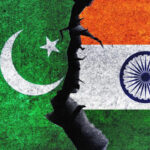Journalists are often shown the power that social media has on policy
Journalism and diplomacy in the “Dark Ages”, i.e., pre-Internet, was a different world. Officers of the Ministry of External Affairs (MEA) and Ambassadors were not available on mobile or on messaging services such as WhatsApp and Telegram, but only on a landline, and calls would be routed through a personal secretary. When news broke, we didn’t receive mass social media messages with the government’s statement. We had to go to Shastri Bhawan, to the MEA’s External Publicity (XP) Division, to gather information, navigating past the secretarial team. Major statements on foreign policy, notifications, and postings were printed and distributed right there on cyclostyled sheets and the spokesperson would meet print journalists nearly every day and explain the government’s position on a subject. Diplomatic relations were equally discreet. If an Ambassador was summoned or a major spat broke out, journalists had to rely on their sources to confirm that, which sometimes took days, if not weeks, by which time the issue may have cooled off. Much has changed since. Today, diplomatic spats are not only created in an instant; the whole story plays out in real time, worldwide.
This week’s India-Maldives tussle is a great example of a diplomatic crisis created and dealt with on social media. The trigger: egregious social media posts by Maldivian Ministers about Prime Minister Narendra Modi in particular and Indians in general. The Ministers, who have since been suspended by their government, appeared to be responding to a social media campaign in India that promoted Mr. Modi’s visit to Lakshadweep not just as a pitch for Indian tourism, but as a “masterstroke” to “checkmate” the Maldives, whose newly elected government has taken a number of decisions that have upset New Delhi. Eventually, the outrage by Indians on social media forced the MEA to act. It issued a tough statement and summoned the Maldives Ambassador to South Block. An online #BoycottMaldives campaign, promoted by Indian travel companies and celebrities, even targetted journalists who travelled to Male to cover the story. The outcome overshadowed the diplomatic narrative however, and probably did more damage to the bilateral relationship than the MEA may have bargained for.
The Maldives incident was unusual as the offensive tweets were put out by Ministers themselves. But nowadays, the MEA reacts to statements by non-officials as well. Most recently, a video by an Indian student in Europe showed posters outside a United Nations building criticising Mr. Modi and the government. The Indian student was upset and video went viral as activists on social media demanded that the MEA take up the “insult” firmly. Within hours, the Ambassador of the European country was “summoned” to the Foreign Office, and a press note was issued on social media. It is puzzling to imagine what the MEA thought the European country could actually do about posters outside the UN office, where protests against dozens of countries are recorded every day. Diplomats were even more perplexed when the MEA decided to respond directly to social media posts by a famous popstar and by a teenage environmental activist who criticised the government for action against farmers protesting three farm bills on the outskirts of Delhi. The MEA termed the interest of international celebrities in the protests as “vested” and “agenda-driven”. It was unclear why the Ministry was responding to them at all.
As journalists, we are often shown the power that social media has on policy. Questions we ask at briefings receive less response than a viral post does. We find ourselves covering made-on-the-Internet stories rather than real developments. The answer may not be, paraphrasing the poet Dylan Thomas, to “Outrage, outrage against the dying of the light”, but instead to separate the issues that affect India’s foreign policy from the non-issues that don’t, and to address them without allowing an Internet storm-in-a-teacup to overtake normal diplomatic discourse.
Outrage, outrage into the dying of the light
Journalists are often shown the power that social media has on policy
Journalism and diplomacy in the “Dark Ages”, i.e., pre-Internet, was a different world. Officers of the Ministry of External Affairs (MEA) and Ambassadors were not available on mobile or on messaging services such as WhatsApp and Telegram, but only on a landline, and calls would be routed through a personal secretary. When news broke, we didn’t receive mass social media messages with the government’s statement. We had to go to Shastri Bhawan, to the MEA’s External Publicity (XP) Division, to gather information, navigating past the secretarial team. Major statements on foreign policy, notifications, and postings were printed and distributed right there on cyclostyled sheets and the spokesperson would meet print journalists nearly every day and explain the government’s position on a subject. Diplomatic relations were equally discreet. If an Ambassador was summoned or a major spat broke out, journalists had to rely on their sources to confirm that, which sometimes took days, if not weeks, by which time the issue may have cooled off. Much has changed since. Today, diplomatic spats are not only created in an instant; the whole story plays out in real time, worldwide.
This week’s India-Maldives tussle is a great example of a diplomatic crisis created and dealt with on social media. The trigger: egregious social media posts by Maldivian Ministers about Prime Minister Narendra Modi in particular and Indians in general. The Ministers, who have since been suspended by their government, appeared to be responding to a social media campaign in India that promoted Mr. Modi’s visit to Lakshadweep not just as a pitch for Indian tourism, but as a “masterstroke” to “checkmate” the Maldives, whose newly elected government has taken a number of decisions that have upset New Delhi. Eventually, the outrage by Indians on social media forced the MEA to act. It issued a tough statement and summoned the Maldives Ambassador to South Block. An online #BoycottMaldives campaign, promoted by Indian travel companies and celebrities, even targetted journalists who travelled to Male to cover the story. The outcome overshadowed the diplomatic narrative however, and probably did more damage to the bilateral relationship than the MEA may have bargained for.
The Maldives incident was unusual as the offensive tweets were put out by Ministers themselves. But nowadays, the MEA reacts to statements by non-officials as well. Most recently, a video by an Indian student in Europe showed posters outside a United Nations building criticising Mr. Modi and the government. The Indian student was upset and video went viral as activists on social media demanded that the MEA take up the “insult” firmly. Within hours, the Ambassador of the European country was “summoned” to the Foreign Office, and a press note was issued on social media. It is puzzling to imagine what the MEA thought the European country could actually do about posters outside the UN office, where protests against dozens of countries are recorded every day. Diplomats were even more perplexed when the MEA decided to respond directly to social media posts by a famous popstar and by a teenage environmental activist who criticised the government for action against farmers protesting three farm bills on the outskirts of Delhi. The MEA termed the interest of international celebrities in the protests as “vested” and “agenda-driven”. It was unclear why the Ministry was responding to them at all.
As journalists, we are often shown the power that social media has on policy. Questions we ask at briefings receive less response than a viral post does. We find ourselves covering made-on-the-Internet stories rather than real developments. The answer may not be, paraphrasing the poet Dylan Thomas, to “Outrage, outrage against the dying of the light”, but instead to separate the issues that affect India’s foreign policy from the non-issues that don’t, and to address them without allowing an Internet storm-in-a-teacup to overtake normal diplomatic discourse.






NO COMMENT